Centauri Dreams
Imagining and Planning Interstellar Exploration
Beneath a Methane Sea
Back when Cassini was approaching Saturn and we all anticipated the arrival of the Huygens payload on the surface, speculation grew that rather than finding a solid surface, Huygens might ‘splash down’ in a hydrocarbon sea. I can remember art to that effect in various Internet venues of the time. In the event, Huygens came down on hard terrain, but since then Cassini’s continuing surveys have shown that seas and lakes do exist on the moon. Over 1.6 million square kilometers (about two percent of the surface of Titan) are covered in liquid.

Image: Ligeia Mare, shown here in a false-colour image from the international Cassini mission, is the second largest known body of liquid on Saturn’s moon Titan. It measures roughly 420 km x 350 km and its shorelines extend for over 3,000 km. It is filled with liquid methane. The mosaic shown here is composed from synthetic aperture radar images from flybys between February 2006 and April 2007. Credit: NASA/JPL-Caltech/ASI/Cornell.
The liquid, of course, is not water but methane and ethane, existing in an atmosphere that is almost 95 percent nitrogen (with methane, small amounts of hydrogen and ethane making up the rest). Cassini has shown us three large seas near the north pole that are surrounded by numerous smaller lakes, while only a single lake has thus far been found in the southern hemisphere. New work on Cassini flyby data between 2007 and 2015 now confirms that Ligeia Mare, one of Titan’s largest seas, is made up primarily of liquid methane.
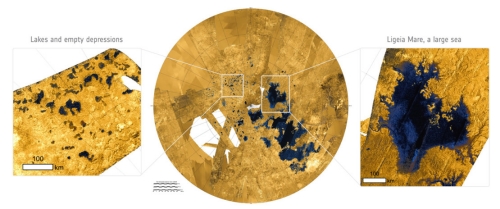
Image: A radar image of Titan’s north polar regions (centre), with close ups of numerous lakes (left) and a large sea (right). The sea, Ligeia Mare, measures roughly 420 x 350 km and is the second largest known body of liquid hydrocarbons on Titan. Its shorelines extend for some 2000 km and many rivers can be seen draining into the sea. By contrast, the numerous lakes are typically less than 100 km across and have more rounded shapes with steep sides. Credit: NASA/JPL-Caltech/ASI/USGS; left and right: NASA/ESA. Acknowledgement: T. Cornet, ESA.
The finding is a bit surprising given that ethane is produced when sunlight breaks methane molecules apart. Thus expectations for Ligeia Mare involved primarily ethane. Alice Le Gall (Laboratoire Atmosphères, Milieux, Observations Spatiales and Université Versailles Saint-Quentin, France), who led the new study, comments on the finding:
“Either Ligeia Mare is replenished by fresh methane rainfall, or something is removing ethane from it. It is possible that the ethane ends up in the undersea crust, or that it somehow flows into the adjacent sea, Kraken Mare, but that will require further investigation.”
As this work progressed, Le Gall and team relied on a radio sounding experiment performed in 2013, described in this ESA news release. The radio sounding, led by Marco Mastrogiuseppe, detected seafloor echoes and was able to derive the depth of Ligeia Mare along Cassini’s track, which marked the first time we have ever detected the bottom of an off-Earth sea. The deepest depth recorded was 160 meters. Le Gall used the sounding data along with observations of thermal emissions from Ligeia Mare at microwave wavelengths in her work.
The result: The new paper reports that the researchers were able to separate the thermal emissions from the seafloor from those of the liquid sea. The seabed is found to be covered by what Le Gall calls “a sludge layer of organic-rich compounds.”
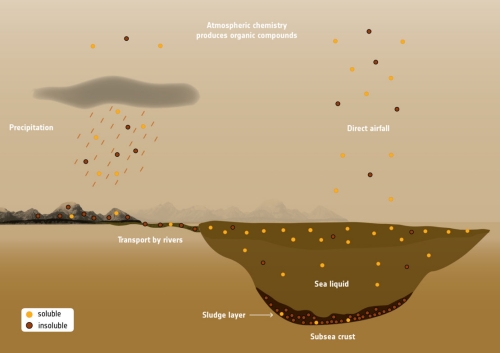
Image: How different organic compounds make their way to the seas and lakes on Titan, the largest moon of Saturn. A recent study revealed that Ligeia Mare, one of Titan’s three seas, consists of pure methane and has a seabed covered by sludge of organic-rich material. Credit: ESA.
You can see the process at work in the image above. Nitrogen and methane in Titan’s atmosphere produce organic molecules, the heaviest of which fall to the surface. Reaching the sea through rain or one of Titan’s rivers, some are dissolved, while others sink to the ocean floor. We also find that the surface areas surrounding the lakes and seas are likely flooded with liquid hydrocarbons, based on the lack of temperature change between the sea and the shore.
The paper is Le Gall et al., “Composition, seasonal change, and bathymetry of Ligeia Mare, Titan, derived from its microwave thermal emission,” Journal of Geophysical Research: Planets, published online 25 February 2016 (abstract). Marco Mastrogiuseppe’s work on the depth of Ligeia Mare is described in “The bathymetry of a Titan sea,” Geophysical Research Letters, published online 4 March 2014 (abstract).

Gravitational Lensing with Planets
As we’ve been talking about the Sun’s gravitational focus, it’s interesting to reflect on the history of its study. Albert Einstein’s thinking about gravitational lensing in astronomy was explicitly addressed in a 1936 paper, but it wasn’t until 1964 that Stanford’s Sydney Liebes produced the mathematics behind lensing at the largest scale, working with the lensing caused by a galaxy between the Earth and a distant quasar. Dennis Walsh, a British astronomer, found the first actual quasar ‘image’ produced in this way back in 1978, with Von Eshleman’s study of the Sun’s lensing the following year including the idea of sending a spacecraft to 550 AU.
SETI was on Eshleman’s mind, for he pondered what could be done at the 21 cm wavelength, the SETI ‘waterhole,’ and so did Frank Drake, who presented a paper on the concept in 1987. If you have a good academic library near you, its holdings of the Journal of the British Interplanetary Society for 1994 will include the proceedings of the Conference on Space Missions and Astrodynamics that Claudio Maccone organized two years earlier. FOCAL was now being considered, though in a mission then called SETISAIL, even though SETI would be only one aspect of its scientific investigations.
FOCAL Beyond Stars
Finding ways to exploit the gravitational lens of the Sun forces us to take into account the Sun’s corona, a problem both Eshleman (Stanford) and Slava Turyshev (JPL) soon addressed. We’d like to get a spacecraft not just to 550 AU, but well beyond it to avoid coronal distortion, taking advantage of the fact that we are not dealing with a focal point but a focal line. Let me quote one of Claudio Maccone’s papers on this (citation at the end of this post):
…a simple, but very important consequence of the above discussion is that all points on the straight line beyond this minimal focal distance are foci too, because the light rays passing by the Sun further than the minimum distance have smaller deflection angles and thus come together at an even greater distance from the Sun.
Thus we have the ability to move well beyond 550 AU, and in fact have no choice but to do so. The Sun’s corona creates what Maccone calls a ‘diverging lens effect’ and opposes the converging effect we associate with a gravitational lens. The result is that the minimum distance the FOCAL craft must reach (here I’m paraphrasing the paper) is higher for lower frequencies (of the source electromagnetic waves crossing the Solar corona) and lower for higher frequencies. Thus at 500 GHz, the focus is about 650 AU. At 160 GHz, the focus is at 763 AU.
But are we limited to using the Sun and, if we build radio ‘bridges’ as discussed yesterday, nearby stars as gravitational lenses? It turns out that planets too can be used for this purpose. In his 2011 study of this idea, which appeared in Acta Astronautica, Maccone produces the needed equations, noting that the ratio of a planet’s radius squared to its mass lets us calculate the distance a spacecraft must reach to take advantage of planetary lensing. From that we have defined what he calls the planet’s focal sphere.
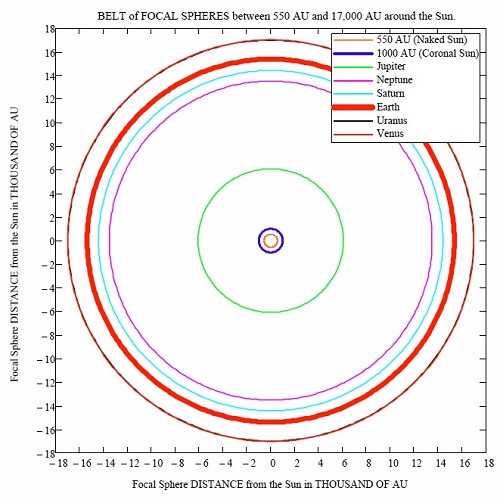
Image: The complete BELT of focal spheres between 550 and 17,000 AU from the Sun, as created by the gravitational lensing effect of the sun and all planets, here shown to scale. The discovery of this belt of focal spheres is the main result put forward in this paper, together with the computation of the relevant antenna gains. Credit: C. Maccone.
Lensing Moves into the Oort Cloud
The figure above may contain a few surprises. We would expect Jupiter to top the list of planetary lenses, and indeed, its focal sphere is the next out from the Sun at 6100 AU. That’s a useful number to keep in mind, because we may discover that the Sun’s coronal effects are simply too powerful to overcome to produce the needed images. If so, we have a target halfway out to the inner Oort Cloud that we can also use to study the lensing phenomenon.
Beyond this, notice that Neptune, which has a high ratio between the square of its radius and its mass, comes next, at 13,525 AU. Saturn’s focal sphere is 14,425 AU out, and next we find our own Earth, with a focal sphere at 15,375 AU. Our planet makes a better lensing candidate than Uranus because it is the body with the highest density (ratio of mass to volume) in the Solar System. Maccone likes to point out that because we know the Earth’s surface and atmosphere better than that of any other planet, a FOCAL mission using the Earth as a lens would begin with a significant advantage as we try to untangle a lensed image of a distant object.
How would we take advantage of these planetary focal spheres? They extend all the way out to 17,000 AU in the case of Venus. As the figure makes clear, a fast spacecraft departing the Solar System could examine any of them in turn, beginning with observations as the Sun’s coronal effects begin to subside. Noting that a spacecraft enroute to Alpha Centauri would cross all these focal spheres, Maccone muses on the results of such a crossing:
First of all, while the Sun does not move in the Sun-centered reference frame of the Solar system, all the planets do move. This means that they actually sweep a certain area of the sky, as seen from the spacecraft, so that a spacecraft enjoys a sort of moving magnifying lens. How many extrasolar planets would fall inside this moving magnifying lens? Well, we don’t know nowadays, of course, but the over 400 exoplanets found to date [the paper appeared in 2011] are a neat promise that many more such exoplanets could be detected anew by a suitably equipped spacecraft crossing the distances between 550 and 17,000 AU from the Sun thanks to the gravitational lenses of the planets.
Such discoveries would be serendipitous, to say the least, as our Alpha Centauri mission would just be seeing what happened to be in line with the planet being studied as it departed the system. But having Jupiter at 6100 AU and the Earth at 15,375 AU does offer us useful targets for experimentation with the technologies we’ll need to tease images out of a focal sphere encounter. One of the big if’s of Breakthrough Starshot is the construction of operation of the phased laser array. But if it is built and we can achieve velocities of a significant fraction of c, then dedicated missions to explore planetary lensing would be sensible.
Clearly the Sun is our first choice as a gravitational lens not just because of the relative proximity of its minimum focal distance (550 AU) but because the effective gain of the Sun is so much higher than that of Jupiter, and far higher than the low gain we could expect to achieve with the Earth as a gravitational lensing body. Maccone calculates numerical values for the gain at frequencies ranging from the hydrogen line up to the CMB peak at 160 GHz, evaluating each of these for the Sun’s gravitational lens as well as the focal spheres of the various planets. If we want to work with the lensing potential of planets, we’ll need major advances in antenna and imaging technologies to overcome the weak signatures the planets provide.
The paper is Maccone, “A New Belt Beyond Kuiper’s: A Belt of Focal Spheres Between 550 and 17,000 AU for SETI and Science,” Acta Astronautica Vol. 69, Issues 11-12 (December 2011), pp. 939-948 (abstract).

Starshot and the Gravitational Lens
Although the idea of a mission to the Sun’s gravitational lens has been in Claudio Maccone’s thinking for a long time, it has never been linked with the financial resources of a concept study like Breakthrough Starshot. The Italian physicist led a conference on mission concepts in the early 1990s and submitted a proposal for an ESA mission in 1993. What’s striking to me is that throughout that time, Maccone has explored aspects of the mission he calls FOCAL that at one point seemed far too futuristic for our era. Could we, for example, do SETI with a FOCAL mission? Could we use it to enhance communications with an interstellar probe?
The answer to both is yes, but the problem was pushing a spacecraft out to 550 AU in the first place, a challenge involving flight times of many decades. Then the Breakthrough Starshot initiative emerged and suddenly Maccone found himself in Palo Alto talking about a well-funded study, one that looked to FOCAL to support interstellar probes both in terms of defining their target and enabling their data return. FOCAL was a bit less theoretical, and all those papers over the years now had ramifications in an ongoing mission design.
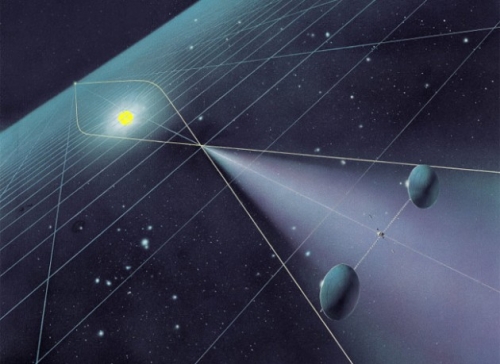
Image: The FOCAL mission as described by Claudio Maccone in his 2009 book Deep Space Flight and Communications (Springer).
Power of the Lens
Stanford’s Von Eshleman was probably the first to think about using the lensing properties of mass to do science at the lensing distance and beyond, though Frank Drake and others have pondered the possibilities of boosting reception at the hydrogen line (1420 MHz), the famous ‘waterhole’ for interstellar communications. But most readers will also be familiar with the astronomical studies that have been conducted using the lensing of distant objects. A galaxy located behind an intervening galaxy can reveal itself by the bending of its light, another way of saying that mass shapes spacetime — the light is still following the shortest possible route.
In a similar way, light from an object directly behind the Sun can be ‘bent’ by the Sun’s mass, converging at the gravitational focus some 550 AU out. This can lead to misconceptions, especially the idea that we have to get a spacecraft to a specific distance and then stop there to take advantage of the effect. Not so — there is no focal ‘point’ here but a focal line. As we move through and past 550 AU, we take advantage of the fact that the focal line extends to infinity. Coronal effects from the Sun are diminished as we continue to travel and we have the opportunity to make observations of the object on the other side of our star.

Image: Claudio Maccone in the hotel lobby the evening before the Breakthrough Discuss conference began. That’s Denise Herzing (Florida Atlantic University) on the left.
A working constellation of FOCAL spacecraft could be critical to the success of a fast flyby mission like Breakthrough Starshot. We want to know as much as possible about what is around Alpha Centauri before we send our first probes. An infrastructure that can push a small sail to 20 percent of lightspeed gets us to the gravitational lens within days. Each spacecraft it delivers can then makes continuous observations as it moves away from the Sun in the direction opposite the Alpha Centauri system.
Speaking before Maccone at the Breakthrough Discuss meeting, Slava Turyshev (Caltech) pointed out that the gain for optical radiation through a FOCAL mission is 1011, a gain that oscillates but increases as you go further from the lens. This gives us the opportunity to consider multi-pixel imaging of exoplanets before we ever send missions to them. Lou Friedman, whose sail experience at JPL involved a study of a possible sail mission to Halley’s Comet, spoke of a FOCAL mission as ‘an interstellar precursor for Starshot or other destinations beyond the Solar System. Right now we are brainstorming,” he added. “We are studying spacecraft requirements to fly within the ‘Einstein ring’ and do the necessary maneuvering.”
I mentioned Von Eshleman above — he was the first to suggest using the gravitational lens for communications purposes in a 1979 paper, and as Slava Turyshev noted, this was where the practical application of General Relativity for space missions was truly born. But it has been Claudio Maccone who developed these ideas in a series of recent papers, noting that laser communications are deeply compromised at interstellar distances because of pointing accuracy problems and the need for power levels far beyond what we might expect from a StarChip.
Building Bridges Between the Stars
Is the gravitational lens, then, what Maccone likes to call a ‘radio bridge’? Bit Error Rate (BER) charts the possibilities. It’s the number of erroneous bits received divided by the total number of bits transmitted. A probe in Alpha Centauri space trying to communicate with a NASA Deep Space Network antenna — using parameters Maccone developed for a mission payload much larger than Starshot — suffers a 50 percent probability of errors (see The Gravitational Lens and Communications). But a FOCAL probe exploiting the gravitational lens picks up the signal without error. In fact, we don’t start seeing errors until we’re fully nine light years out.
I don’t have Maccone’s slides from the Palo Alto presentation, but the figure below comes from one of his papers, and it illustrates the same point.
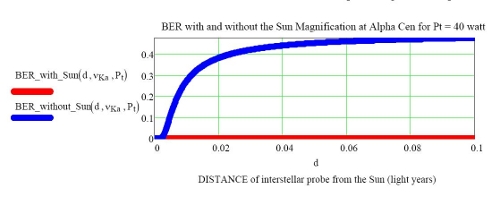
Image: The Bit Error Rate (BER) (upper, blue curve) tends immediately to the 50% value (BER = 0.5) even at moderate distances from the Sun (0 to 0.1 light years) for a 40 watt transmission from a DSN antenna that is a DIRECT transmission, i.e. without using the Sun’s Magnifying Lens. On the contrary (lower red curve) the BER keeps staying at zero value (perfect communications!) if the FOCAL space mission is made, so as the Sun’s magnifying action is made to work. Credit: Claudio Maccone.
But as Maccone told the crowd at Stanford, we do much better still if we set up a bridge with not one but two FOCAL missions. Put one at the gravitational lens of the Sun, the other at the lens of the other star. At this point, things get wild. The minimum transmitted power drops to less than 10-4 watts. You’re reading that right — one-tenth of a milliwatt is enough to create error-free communications between the Sun and Alpha Centauri through two FOCAL antennas. Maccone’s paper assumes two 12-meter FOCAL antennas. StarShot envisions using its somewhat smaller sail as the antenna, a goal given impetus by these numbers.
Now we can start thinking about a galactic communications network. If we can start building out these bridges, we may well be latecomers in the activity. Maccone puts it this way:
The galaxy is a bonanza of stars that can be used as gravitational lenses. There may be civilizations that discovered that fact long ago. Perhaps we are the newcomers. The conclusion is that more advanced civilizations than we might have established sets of radio bridges between stars, a network of radio bridges, a ‘galactic internet.’ If this is true, then the conclusion is that as long as humanity is not capable of reaching the minimal focal distance of our own star, we will remain cut off from rest of galaxy in the sense of SETI.
The conclusion for StarShot: The first FOCAL spacecraft is sent out beyond 550 AU to the region in the sky precisely opposite to Alpha Centauri. This craft acts as our relay satellite, enabling communications between the Earth and any probe reaching our nearest neighbor. The second FOCAL mission is now sent to Alpha Centauri to create the radio bridge. All exploratory missions to come then have robust communications without the need for huge power resources aboard the spacecraft. The gravitational focus is thus our first target.
As Blakesley Burkhart (Harvard-Smithsonian Center for Astrophysics) noted in a follow-up panel, a mission to the gravitational lens contradicts a lot of things astronomers have been taught since their earliest days; specifically, the first thing you learn to do with a telescope is not to point it toward the Sun. FOCAL demands that we do just that, but the rewards are immense, not just in terms of exoplanet imaging and telecommunications, but also in discoveries we can’t anticipate, perhaps involving the Cosmic Microwave Background, itself a wonderful FOCAL target because being isotropic, it removes the need for exquisitely precise targeting.
A Voyager-class spacecraft, said Cornell University’s Zac Manchester, would take 150 years to reach 550 AU, while the Innovative Interstellar Explorer concept, developed in 2003, would reach the gravitational focus in about fifty years, using multiple Jupiter flybys. StarShot’s goal is to move fast enough to reach the lensing area in just a couple of weeks. Manchester noted the need for multiple spacecraft to sample the huge lensed image pixel by pixel. Think in terms of a spacecraft ‘array’ more than one or two craft. Just how we do this in the StarShot framework is something that research teams will be studying for some time to come, given the gradual realization that if you want to do interstellar, you’d better look at FOCAL first.
We’ll also have to take into account Geoffrey Landis’ findings in a paper just now becoming available on the arXiv site. It’s “Mission to the Gravitational Focus of the Sun: A Critical Analysis” (preprint), which looks at problems at realizing the FOCAL concept and in particular at acquiring a workable image. Claudio Maccone’s paper on radio bridges is “Interstellar Radio Links Enhanced by Exploiting the Sun as a Gravitational Lens,” Acta Astronautica Vol. 68, Issues 1-2 (January-February 2011), pp. 76-84 (abstract).

Starshot: Concept and Execution
Because I get irritable when I don’t get my walking in every day, I made sure when I arrived in Palo Alto to cram as much as I could into the day before Breakthrough Discuss began. That meant heading out from the hotel just after noon and putting in about five miles. Palo Alto is a very walkable place and I found myself ambling up and down shady streets past gardens bright with spring flowers. We had superb weather for the entire conference, but naturally when things got going, both days were crammed with talks and long walks were out of the question.

But the day before, as I walked, I pondered the schedule of the conference, wondering how a mission to Alpha Centauri fit into the overall plan. In addition to the $100 million going toward Breakthrough Starshot, Breakthrough Initiatives has also put up $100 million for its SETI project, which has already begun operations at Green Bank (West Virginia) and is slated to operate at the Parkes dish in Australia as well, giving SETI the services of two of the largest steerable dishes in the world. But as we’ve seen, SETI fit into the Starshot discussion because beamed laser technologies are an observable, and one that can be seen from a long way off.
The focus on Alpha Centauri also turned out to be a natural for Starshot. If you’re hoping to build a mission, one of your first priorities is to understand the target. Here we’re very close to learning what kind of planets are available around the three stars in the Alpha Centauri system, and what other challenges by way of dust and debris we may encounter with a fast probe through the plane of any planets found there. And of course a technology that can get us to Alpha Centauri is an enabler for a gravitational lens mission, which I’ll discuss more on Monday.
Miracles Required?
In more than one overheard conversation a sentence more or less like this one occurred: “Just how many miracles are required to get this plan to work?” The theory being that one miracle is OK, because we can’t discount how fast technology is developing, and two miracles might also work, because we can’t know in which direction we’re going to be surprised. But as miracles pile up, the odds become more daunting. That’s why Breakthrough Starshot is spending $100 million. That’s far less than the actual mission would require, but it’s a more than workable amount to create the kind of concept study which is what is in Starshot’s immediate future.
As Pete Worden, former director of NASA Ames and now executive director of Breakthrough Initiatives made clear, there is a process here through multiple grants, research and experiments that will attack the problem of sail beaming at every level, addressing along the way the issues of data return, dust mitigation during the flight, beamer construction, sail materials technology and all the other matters that bedevil so futuristic a concept. Breakthrough Starshot will hope to complete the study with a scaled-down prototype of the mission hardware.
Kepler’s famous letter to Galileo came up not just in Worden’s keynote on day two but in several other talks, it being the first time using sails in space in any realistic way was introduced. Here’s the relevant quote:
There will certainly be no lack of human pioneers when we have mastered the art of flight… Let us create vessels and sails adjusted to the heavenly ether, and there will be plenty of people unafraid of the empty wastes. In the meantime, we shall prepare for the brave sky-travelers maps of the celestial bodies. I shall do it for the moon, you Galileo, for Jupiter.
That was written in 1610, and it reminds us that despite their misconceptions about what they would find in space, the early pioneers of astronomy could draw sound conclusions from their observations. Kepler had studied comets and viewed the fact that comet tails always pointed away from the Sun as evidence for a ‘solar wind’ that could be harnessed by space travelers. We might also remember that Kepler wrote an early science fiction tale called the Somnium, a journey to the Moon accomplished through supernatural means, but with an attempt to be as scientifically accurate as possible given knowledge of the day.
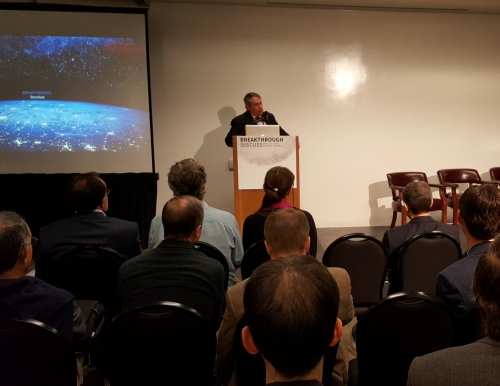
Image: In a new and much smaller room, day two of Breakthrough Discuss began with Pete Worden’s keynote.
Today’s beamed sail draws on trends that were not obvious even decades ago when science fiction writers and physicists alike described the sail missions we might one day fly. Today nanotechnology is helping us build materials one molecule at a time, Worden said, while we have a continuing decrease in size and increase in complexity in electronics, along with advances in lasers and fiber optics that point toward creating phased laser arrays. A key question, of course, is this: Does something like Moore’s Law apply to laser technologies? And how far can we extrapolate it taking us?
The Starchip we would like to see deployed on the Starshot is about the size of a postage stamp, for as I’ve said before, this is a spacecraft more like a smartphone than a macro-scaled capsule with beams and struts. In Worden’s words:
“The Starchip. enabled by phone technologies, is under 1 gram in mass. That makes it 1 million times lighter than an ordinary spacecraft, and on this chip we can carry cameras, thrusters, navigation and communications equipment at the cost of an iPhone. NASA doesn’t like to build anything small, but I’m now seeing JPL doing all sorts of things with smaller satellites. As to the sail, nanotechnology is key to building a sail 300 atoms thick that has to hold together and not absorb much energy, but transmit and reflect energy. Experiments will start soon.”
These are huge requirements, for we need a sail as light as smoke that can nonetheless maintain its structural integrity when hit by the beam from a phased laser array that will accelerate it at 60,000 g’s to twenty percent of the speed of light. The slightest absorption of heat will fry the sail, and it had better be engineered to the tolerances needed to stay on the beam, which is going to involve a great deal of investigation. The only laboratory work on microwave sail beaming I’m aware of, conducted by the Benford brothers, implies the need for a cone-shaped sail of a specific topology that will also spin, riding the beam rather than being deflected from it. What we need now is lab work involving laser-beaming to clarify these matters.
Can the sail and chip withstand the beating they’ll take from the laser array? 60,000 g’s seems astonishing, but Worden noted that the chip has to survive only a few minutes of this, and the technology to protect it is developing rapidly, there being artillery rounds that do guidance and propulsion and withstand 100,000 g’s even now. The starships would be deployed by a ‘mothership’ in a highly elliptical orbit, after which the mothership would depart the area to allow the beam to work its magic on the sails. Two minutes to 20 percent of the speed of light.
A Full Array of Challenges
A four-meter sail produced in great numbers and capable of riding a powerful laser beam would be the kind of enabler Robert Forward used to think about, though in the days when he took an interstellar program to the US Congress (see his “A National Space Program for Interstellar Exploration,” as discussed in Roadmap to the Stars, a 2013 Centauri Dreams entry), he was talking about much larger ships. In his document, which was published by the House Committee on Science and Technology, Forward talked about sending automated probes to nearby star systems by the turn of the 21st Century, beginning with a 15-year period of mission definition studies and work on key technology areas. This was in 1975, and I can only imagine what Forward would have thought of having $100 million to pursue the idea.
Now we think small on the one end — the sail, the payload — and large on another — the beamer. Phase locking combines the output of an array of lasers into a single focused beam, with Worden describing “network effects that amplify the beam into a laser wind of 50 gigawatts.” If we can build something like this, perhaps in Chile’s Atacama desert, perhaps in Antarctica, we could theoretically create a modular and scalable system that could make Forward’s dream a reality, sending fast flybys to a host of nearby stars at tens of thousands of kilometers per second.
It was great to talk to Mason Peck at the Breakthrough Discuss meetings, especially since his work at Cornell on the tiny spacecraft he calls ‘Sprites’ has led directly to ideas like Starchip. Both Peck and Zac Manchester, also at the conference, have worked in the Cornell lab on the Sprite technology, each of these 32 x 32 x 4mm in size and weighing less than 7.5 grams. You can see a rundown of these chip-sized satellites in Sprites: A Chip-Sized Spacecraft Solution, which I wrote in 2014. At lunch on the second day of the conference, Peck showed several of us a Sprite, whose implications in swarm technology missions continue to fascinate me.
But back to the beamer. Worden said that the Atacama desert might be the best location of those considered — the Kalahari, the Australian outback, Antarctica — because it has more infrastructure, and power might be bought from utilities or produced through systems built by the project itself, perhaps solar, perhaps nuclear. Space hasn’t entirely been ruled out, but it’s hard to see us ready to build a huge, privately funded laser installation in space even within several decades. For that matter, you can imagine the political issues involved in placing a laser that could be weaponized anywhere near Earth orbit.
The Starshot sail would fly edge-on to minimize the cross-section exposed to matter in the interstellar medium. Here we’re dealing with a lot of unknowns because we’ve only gotten one mission out beyond the heliopause, and it — Voyager — wasn’t designed to do the kind of measurements we’d like to have about the Local Interstellar Medium (LISM). But based on what we do know about local ‘bubbles’ in the medium and our Sun’s position in them, a fast mission to Alpha Centauri seems survivable at least by some of the craft thrown at it. Redundancy thus becomes crucial, which is why the plan is to send a large number of sails.
And here we arrive at yet another challenge, or ‘miracle’ if you will. We’ll look at getting a signal back to Earth on Monday, but the plan is to use the sail itself as an optical element, turning it into a phased receiver as well as a transmitter. The tolerances needed in doing this, and the technologies required to shape the sail at its destination, remain unexplored territory. We have to ensure that this element is not the showstopper. As you might expect, data reception back on Earth is to be handled through the enormous laser array that sent the craft.
That array also serves as a kilometer-class telescope, meaning it would have a useful future of continuing astronomical observation. And as a beamer, says Worden, the laser array is multi-purpose. A successful beamer could make possible any number of missions within the Solar System and beyond, including the gravitational lens FOCAL mission. We have to remember we’re not just targeting Alpha Centauri. “We’re convinced we can contemplate in this century, and perhaps in a single generation, expanding the human reach to the stars.” Note the plural.

I’ve only mentioned some of the larger challenges Breakthrough Starshot will face. At the Yuri’s Night celebration, Worden showed a slide listing nineteen, as seen in the image above. These suggest and certainly do not exhaust the list of issues that Starshot raises. In my last Breakthrough Discuss report on Monday, I’ll look at how the FOCAL mission to the Sun’s gravitational lens fits into the mission, with thoughts on where we go from here.

Breakthrough Discuss: SETI in the Optical
At the Yuri’s Night party on Yuri Milner’s Palo Alto estate, I found myself thinking about a novel, Allen Steele’s Arkwright. Like Breakthrough Starshot, initial work on the starship in the book is funded by a wealthy man who wants to see a human future among the stars. The propulsion method is a beam-driven sail, though at that point the comparisons get strained, for Steele is assuming a much larger craft and a mission of colonization rather than a flyby. Even so, there was enough similarity to make a book I had been reading on the airplane seem prescient.
The music on Yuri’s Night was loud, the gathering crowd relaxed, and I had imagined it would be an entirely social event, but after a time we were called in to watch a short video about Starshot and then participated in a question-and-answer session with some of the project’s principal players, including Milner himself. It was a good chance to hear some of the challenges the project faces examined, and tomorrow we’ll look at many of these. We also have to dig back into the gravitational focus mission and its role in all this.
But I kept thinking about Steele’s target planet, around Gliese 667C, and pondering interstellar distances. Alpha Centauri is 40,000,000,000,000 kilometers out, a whopping 271,000 AU. I seemed to be feeling the distance as an almost tangible thing, suddenly realizing that I was completely frazzled from the day’s sessions. I’m compulsive about note-taking (I would wind up with 52 single-spaced pages on my MacBook), and that feeling of distance fatigue was actually a very physical weariness. I made an early night of it (and thank you, Jill
Tarter and Jack Welch, for your kind offer of a ride back to the hotel). I slept that night like I haven’t slept in years.

Time to Target
That morning, in the opening session on optical SETI, I had been wondering whether key papers, like the Cocconi and Morrison paper that launched serious SETI study in 1959, or the Townes and Schwartz paper that brought optical SETI to our attention, had begun a gradual cultural widening of our horizons. If many people I talk to in everyday life still don’t have a grasp of just how far away even the nearest stars are, it’s still true that SETI has brought the topic of other civilizations to the fore, as reflected in countless science fiction novels and films.
And now that we’re thinking about an actual interstellar mission, it falls to us, as Jill Tarter had reminded the conference that morning, to think about the SETI consequences of pushing sails between planets and stars. Let me quote her on the point:
“A fiducial for optical seti has been a petawatt transmitter focused by a ten meter telescope. And even though we don’t have signs of that kind of technology in our future for interstellar communications, Breakthrough Starshot demonstrates there is reason to believe there may be transient sources of emission as byproducts of other plausible activities.”
Plausible activities include, as we have seen yesterday, a beaming infrastructure within a stellar system that could drive spacecraft on missions of exploration and supply. But we don’t even have to assume that another species is necessarily exploring the cosmos. For surely, like us, they would be aware of the danger of rogue asteroids or comets within their own system, and possibly using beamed lasers to deflect their trajectories. The lesson: If we can imagine it, so can someone else. And if they were to build it, we just may be able to see it.
Eliot Gillum’s talk on optical SETI reinforced these ideas. The director of optical SETI at the SETI Institute, Gillum noted that the older search paradigm had been to look at small patches of the sky for just a few minutes. The assumption here is a continuous or rapidly repeating signal, but beamed power calls upon us to change strategies. ‘All sky all the time’ is Gillum’s solution, given our understanding that beaming presents huge problems of geometry. Are we lined up by chance to see a beam, and would we be able to recognize it when we did?
The beamed SETI observable is a bright transient, and we have more than a few of these in the catalog already, though we don’t know what they are. But Gillum pointed to a program called AllSat as an indication of how we might proceed. It’s a highly automated program whose prototype is now under construction, using multiple cameras to observe fields of view of 120 degrees. AllSat is about signal detection, not detailed characterization, but its six primary observatories would be a full-sky search allowing follow-up at higher apertures.
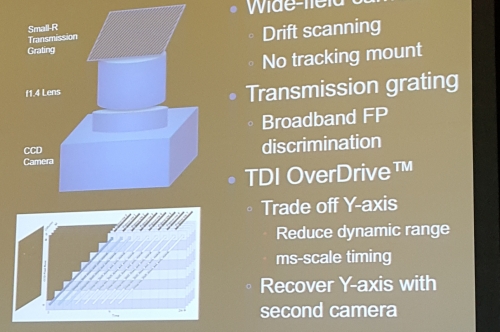
Image: Equipment for an all-sky optical SETI survey, as shown on one of Eliot Gillum’s slides.
Fast, sporadic, bright targets we would miss with older optical SETI methods should become observable in a five-year survey of the entire sky. Harvard’s Paul Horowitz discussed new photon-counting detectors and showed a notional design of a telescope that could be built around them. Horowitz and team began searching for intense laser pulses in 1998, understanding that the beam produced by a high-intensity pulsed laser teamed with a moderate-sized telescope — something that could be built with current technology — would appear during its pulse a thousand times brighter than the Sun.
But it was Philip Lubin (UC-Santa Barbara) who made the most explicit link between optical SETI and what Breakthrough Starshot is doing. Lubin told me during a break that the genesis of the current beamed sail concept as conceived by Starshot grew out of his recent “Roadmap to Interstellar Flight,” a lengthy paper submitted to the Journal of the British Interplanetary Society and available here. I should also mention in relation to SETI that a new paper, “The Search for Directed Intelligence” has just become available on the arXiv site.
The space for life to flourish in the universe is all but boundless, Lubin said, showing a one square degree image from the Hubble Ultra Deep Field and noting that 1018 planets could be in the view.
“We can stare at one square area of the sky and be looking at trillions of planets all the way out to a modest redshift,” Lubin said. “As to detection probability, consider that we are about to enable a class 4 civilization with Starshot. The beam — a phased array beam small enough to hit individual stars — would be detectable out to enormous distances with a modest telescope… Phased array telescopes grow out of technology like Starshot. We can take a picture, look along the line of sight, and know that vast numbers of planets are in that field of view.”
I should mention that Lubin’s civilization classification is not Kardashev’s; he’s drawing on a scale he discusses in his most recent paper, one in which Kardashev Level 1 is a Class 11. But whatever the classification, it’s clear that a beamed laser infrastructure raises questions about our own planet’s visibility, which invariably opens the METI (Messaging to Extraterrestrial Intelligence) debate. It was not a subject the conference spent a lot of time on, though it was clear from remarks I heard that opinion was sharply divided between those who found restrictions on METI pointless and those who called for consensus among a variety of disciplines before actively trying to raise the visibility level of our own civilization.
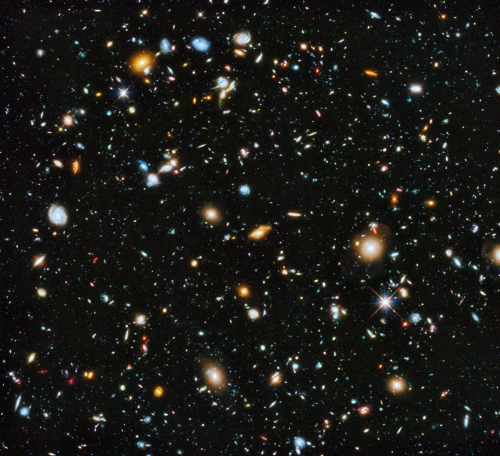
Image: Looking into the Hubble Ultra Deep Field. Credit: NASA, ESA, H. Teplitz and M. Rafelski (IPAC/Caltech), A. Koekemoer (STScI), R. Windhorst (Arizona State University), and Z. Levay (STScI).
Extracting a SETI Signal from our Data
Amy Reines (NOAO) would follow Lubin with an analysis of narrowband SETI searching using radial velocity data. In radial velocity work, we are looking for the tiny Doppler shift an orbiting planet can produce in a star’s spectrum. A laser beam would need to outshine the star’s stellar photon noise, and Reines calculated that most lasers on Earth are already approaching a value that would allow such detections. This assumes a continuous laser beam rather than a pulse, the latter demanding higher power, and it must be directed at us to be detected.
Reines’ computer code could search spectra for possible laser emission lines, comparing a reference spectrum for each star to all other spectra of the star while eliminating random noise fluctuations. Most candidates for a laser turned out to be cosmic rays that hit the detector. One possible hit emerged, a spectral feature seen in three observations of the same star at the same wavelength, but the excitement was short-lived, as the ‘hit’ turned out to be an artifact in the CCD detector. But the methods can be applied to many optical SETI data mining studies.
We can also extend optical pulse SETI into the near-infrared, as Shelley Wright (UC-San Diego) explained, citing new near-infrared photomultiplier tubes (PMT) and avalanche photodiodes (APDs) — these exploit the photoelectric effect to convert light into electricity. We are moving, she said, to higher gain, lower noise and a larger dynamic range in the available instrumentation. The NIROSETI (Near-infrared Optical SETI) instrument built by Wright’s team at Lick Observatory exploits infrared’s advantages in the first near-infrared SETI experiment.
Of course, we might consider not sending or receiving optical or radio data, if Chris Rose is right. Arguing that we should ‘write, not radiate’ our data, Rose (Brown University) wrote a paper with Gregory Wright in 2004 that calculated the energy needed to communicate a given payload of bits. Maybe we should consider sending an artifact packed with information rather than an electromagnetic signal of any kind. If you’ve been reading Centauri Dreams for a long time, you’ll recognize the argument I wrote about in ET in a Grain of Sand.
Rose believes that it can be many orders of magnitude better (from the perspective of energy use) to write a message onto a medium and actually deliver it physically to the recipient, than to send it by radio or laser signal. Clearly he’s not talking about ongoing communications but archival purposes, such as a civilization wanting to send out a record of its great works (here the Voyager golden records come to mind). And he makes the case that for these latter purposes, a truck — or spacecraft — filled with storage media is a very reliable high bit-rate channel.
Of course, it has latency issues — it takes, on the interstellar scale, a long time to get where it’s going. It was a lively presentation punctuated by the question of how we might detect such ‘packages’ of data if they have already been sent to our system from another star. An even bigger question is what Rose described as ‘incursion or evolution.’ Are we ourselves the product of another civilization’s outreach, a ‘seeding’ of the cosmos in our stellar neighborhood? For that matter, should we consider seeding the universe ourselves as well as communicating?

Image: A panel discussion on SETI followed the talks. From left: Jill Tarter, Jim Benford, James Cordes (Cornell), Andrew Howard (University of Hawaii at Manoa), Andrew Siemion (UC-Berkeley), and Dan Werthimer (UC-Berkeley).
Tomorrow I want to draw on the Yuri’s Night panel on Breakthrough Starshot as well as Pete Worden’s talk on the second day of the conference. We need to run through some of the bigger Starshot challenges, and also discuss how the project might evolve over time. I had hoped to get into the gravitational lens dimension of this initiative, but rather than skimping on the presentation, I think I’ll target that for a concluding Breakthrough Discuss post on Monday.

Alpha Centauri, SETI and Detectability
Heading for the hotel lobby the first night of the Breakthrough Discuss meeting, I thought about a major theme of the Breakthrough Starshot initiative: Making things smaller. Robert Forward wrote about sails hundreds of kilometers in diameter, and vast lenses deep in the Solar System to collimate a laser beam that would drive them. But Breakthrough Starshot is looking at a sail four meters across, carrying a payload more like a smartphone than a cargo ship. That big lens in the outer system? No longer needed if we can power up the sail close to home.
How to Look at Alpha Centauri
Digitization works wonders, and Moore’s Law takes us into ever smaller and more tightly packed realms on silicon chips. The trend affects every aspect of spaceflight and astronomy, as witness ACEsat, a small coronagraph mission with an explicit mission, the search for planets around Alpha Centauri A and B. Ruslan Belikov (NASA Ames), working with Northrop Grumman, led the team that conceived this mission, which was recently submitted for NASA Small Explorer funding. The funding did not come through, but the ACEsat idea persists.
At Breakthrough Discuss, we heard Ruslan Belikov describe the mission. Lead author of a recent paper on the work (“How to directly image a habitable planet around Alpha Centauri with a 30-45cm telescope,” available here), Belikov showed a half-scale model of ACEsat that was small enough to hold in your hand. The mission as currently conceived uses a 35 centimeter by 18 cm optical mirror, fits into a CubeSat, and in the view of its creators, is capable of directly imaging Earth-like planets around Alpha Centauri (see ACEsat: Alpha Centauri and Direct Imaging, Ashley Baldwin’s article from last December, for more).
“Alpha Centauri isn’t the tip of the iceberg,” Belikov told conference attendees during a panel discussion on exoplanet detection. “It is the iceberg. We know that small stars like Barnard’s Star or Proxima Centauri have small habitable zones. But nature has given us Alpha Centauri, a favorable outlier — think about how large its habitable zone appears on the sky in terms of its angular size. We would need a telescope three times larger for other stars.”
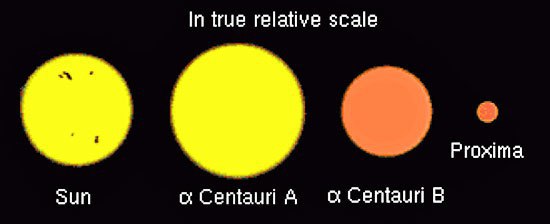
Image: Stars in the Alpha Centauri system as compared with the Sun. Credit: David Benbennick. CC BY-SA 3.0.
When asked what surprises we would find around the Alpha Centauri stars, Sara Seager (MIT) suggested that the biggest surprise would be finding a true Earth twin with life on it, and Belikov was quick to agree — “Sara stole my answer,” he said with a laugh. But Seager would go on to talk about future telescopic efforts focusing on just one object, one specialized type of telescope for each type of star. That more specialized approach seems to fit in nicely with Belikov’s ACEsat concept, tuned as it is for not just a specific type of star but a specific stellar system.
Cornell’s Lisa Kaltenegger urged the audience to think about an Earth ‘twin’ being utterly unlike what we might imagine:
“A world like this could meet our conditions for habitability and yet be much different from the Earth. We can imagine a different kind of biota taking over. When you think about an Earth twin, don’t think about the picture you know. Think yellow, think green, whatever color you want. We can look at some of the exotic deep water fish we find in the ocean and realize that they, as strange as they seem, evolved right here. What might wind up evolving around Centauri?”
Kaltenegger’s remarks drew on her work at the Carl Sagan Institute, where she has built a new interdisciplinary research group spanning ten departments. The effort includes a color catalog that examines the differing reflectivity of various planets depending on possible biota. Which gets us to a major point about Breakthrough Starshot. As Kaltenegger mentioned more than once, data return from the nearest stars needs to include more than basic photographic images. Spectroscopic analysis is crucial as we examine planetary atmospheres for biosignatures.
Natalie Batalha (NASA Ames) pointed out that while we all hoped to find planets in the habitable zone of Alpha Centauri, we might consider that a null result there could still leave us with interesting science. We have not resolved the surface features of any main sequence star except for our own Sun. An Alpha Centauri mission gives us the prospect of resolving the surface of three stars, a science windfall that adds to the benefits of the mission.

Image: Exoplanet hunters Sara Seager (left), Lisa Kaltenegger, Natalie Batalha and Debra Fischer during a break at the meeting.
SETI and Its Consequences
The question and answer sessions at Breakthrough Discuss tended to run into our break periods, when many of the issues continued to circulate. A key issue for SETI is that factor in the Drake equation that addresses the lifetime of a technological civilization. Just how long do such entities survive? It’s an issue that lies like morning fog over the SETI landscape as we look at our own problems with the proliferation of powerful weapons systems and ask what happens when small organizations, even individuals, can acquire ever more deadly capabilities.
Here Harvard’s Avi Loeb brought up a point many others had been thinking about, to judge from the ensuing conversations outside. We naturally focus on finding biological life because that is what we are, but the technologies we are discussing remind us off the possibility that life transforms at a certain level of its development into a technological phase that leads to post-biological intelligence. Sara Seager pointed to existing tools like pacemakers and artificial limbs — if life goes post-biological, how do we create a SETI capable of identifying it?
For that matter, what do we do if it’s non-biological, as Denise Herzing (Florida Atlantic University) asked. Researching dolphin communication through the Wild Dolphin Project, Herzing wonders what the signatures of a non-technological species might be. We are only beginning to understand the complexity of dolphin communication. What if a Breakthrough Starshot mission encounters a world with an intelligent, non-technologial species in charge? Is there any way we could identify it?

The SETI session itself, led by Jill Tarter, focused on optical SETI and the new directions it opens to scrutiny. Again, the issue seems timely given the nature of the Starshot initiative, for as we conceive of technologies here on Earth, we then must ask whether equivalent technologies would be visible to us. Breakthrough Starshot envisions using phased laser arrays scaling up to the 100 GW level. As we learn how to create such ‘beamers,’ we have to ask whether the most common SETI signature in the optical might not be transient pulses that are the byproducts of other activities rather than intentional efforts to communicate with us.
Image: Jill Tarter takes the podium to begin the SETI session.
Puzzlingly, Jim Benford’s paper on that very idea was put into the session on using the Sun as a gravitational lens, but the methods Benford is discussing are very much part of the optical SETI landscape. Centauri Dreams readers already know Benford’s findings: Depending on the use of the beamed energy technology, we would indeed be able to detect transient signals from another star with equipment existing today (see Quantifying KIC 8462852 Power Beaming for background). See also “Power Beaming Leakage Radiation as a SETI Observable,” available here).
Moreover, there does exist a communications dimension, as Benford explained:
“SETI messages may be found on power beaming leakage. That leakage is more powerful than any beacons we’ll ever be likely to build, so we should look at transient signals to see if there is a message embedded on them.”
Beamed energy options for an advanced civilization might involve everything from microwave thermal rockets (beaming to orbit) to orbit boosting to interplanetary and even interstellar missions. With each of these missions, you get progressively higher energy usage. And we can certainly go beyond this list of applications into areas like asteroid deflection, which might one day be necessary to adjust a dangerous trajectory using a high-powered laser. Another possibility: Using a beamer to create a thrust (by evaporation and desorption) of a comet’s surface, which might be a technique one day used in terraforming a planet like Mars.
Benford points out that given their visibility over interstellar distances, many of these uses of beamed energy should make us reconsider optical SETI strategy. Rather than focusing on narrow-band transmissions of the kind likely to be found in a beacon, we should look for more powerful beams with a wider bandwidth. Whereas earlier optical SETI work has involved the 1 ? 10GHz microwave band, we might, considering our atmosphere, want to examine bands where lower oxygen and water vapor allow transmission, which means windows at 35GHz, 70 ? 115GHz, 130 ? 170GHz and 200 ? 320GHz.
The caveat is that power beaming is not isotropic but highly directed. The geometry is not always going to favor detection — the fact that we do not see the beam does not mean that it is not there. An interesting suggestion is to revisit the thousands of transients that have been observed and are now stored in the archives of the SETI@home project.
James Guillochon (Harvard) examined rapid travel in the Solar System via lightsails powered by beamed radiation, underlining some of Benford’s points. A lightsail network in the Solar System is the kind of SETI observable Benford and son Dominic have already addressed in their upcoming paper, the point being that leakage around the edges of the sail cannot be avoided. You may recall that Guillochon, working with Avi Loeb, discussed SETI possibilities in 2015 in “SETI via Leakage from Light Sails in Exoplanetary Systems,” available here).

Image: Beautiful weather and a Palo Alto spring made the occasional break a welcome chance to relax.
But enough for today. More SETI discussion tomorrow, after which we move into the Breakthrough Starshot mission itself as described by former NASA Ames director Pete Worden, and the possibilities of the Sun’s gravitational lens as both a mission target and a mission facilitator.


